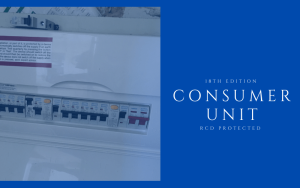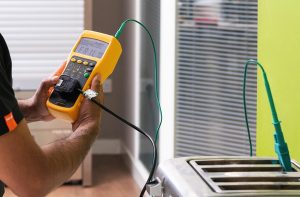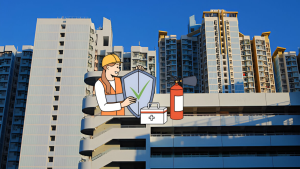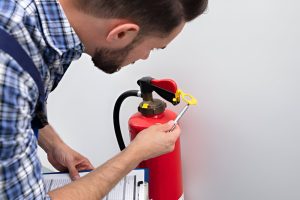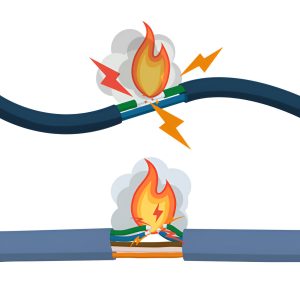Are you a homeowner or business owner who needs an electrical safety certificate check? If so, you’ve come to the right place.
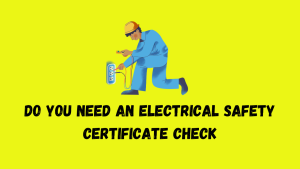
I’m an expert in this field and I understand how important it is for your home and business to be safe from any potential hazards caused by faulty wiring.
In this article, I’ll provide you with some easy steps to help get ready for your electrical safety check. It doesn’t have to be a daunting process!
With just a few simple preparations, you can ensure that everything goes smoothly when the time comes for your inspection. By following my advice, you will make sure that all of your certificates are up-to-date and that you have taken every necessary step towards protecting yourself and others from harm.
So read on, and let’s start preparing for success!
Understanding Electrical Safety Certificates
A spark of electricity is a powerful thing – it can light up your life and power the world. But if not handled safely, it can be incredibly dangerous.
When it comes to electrical safety certificates, understanding how they work and what’s involved in obtaining them is essential for anyone who works with or around electricity.
Electrical testing is at the heart of any electrical safety certificate check. The goal is to ensure that all systems are compliant with established safety standards. This includes inspecting wiring, checking breakers and fuses, making sure outlets are properly grounded, and testing insulation to confirm that no live parts are exposed. It also involves carrying out tests on appliances such as cookers and other equipment which use electricity.
Receiving an electrical safety certificate means that you have taken every reasonable step to make sure your premises meet the required level of protection when using electricity – giving you peace of mind knowing that your home or business environment has been declared safe from potential hazards caused by faulty installations or incorrect usage.
Checking Your Electrical Installation
Now that you have a better understanding of electrical safety certificates, it’s time to move on to the practical side of things and learn how to check your electrical installation.
First off, make sure all equipment is correctly installed in accordance with local regulations before performing any kind of inspection or maintenance. This includes ensuring receptacles are properly grounded and attached securely to the wall, switches and circuit breakers are working correctly, wires are connected firmly without risk of overheating or sparking, and light fixtures do not pose any hazards.
Secondly, always be aware of potential risks when dealing with electricity. You’ll need to pay close attention for signs such as frayed cords, overloaded circuits, poorly insulated wiring or undersized conductors which can all lead to serious problems if left unchecked.
By taking these steps during the initial setup process you’ll save yourself the hassle later down the line should something go wrong.
Once everything has been checked over thoroughly it’s important to keep up regular maintenance so that your electrical system remains safe and hazard-free at all times. This means inspecting outlets each month for damage while also testing GFCI devices regularly by pressing their buttons – this helps ensure they’re working effectively.
Additionally, having an electrician come round every couple of years will provide peace of mind that your systems remain compliant with current standards. Taking these measures now will help you avoid potentially dangerous incidents in future!
Identifying Electrical Hazards
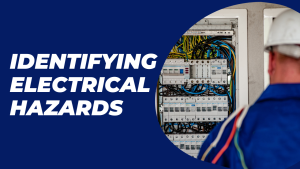
Identifying electrical hazards is a critical part of preparing for an electrical safety certificate check. The process involves assessing existing wiring and equipment, as well as avoiding potential risks such as shocks or electrocution. As the expert carrying out this assessment, you must use your knowledge to identify any issues that may cause harm, without overlooking any areas that could be hazardous down the line.
The first step in identifying these hazards is to assess the condition of all visible wiring and equipment. This means checking for signs of wear and tear, loose connections, exposed wires, damaged insulation and other indicators of poor maintenance.
It also requires being aware of any changes within the building structure – like renovations or new installations – which can introduce new risks into the environment.
Once all these elements have been taken into account, it’s important to implement preventative measures to safeguard against further risks from developing over time. These might include installing ground fault circuit interrupters (GFCIs) where necessary; making sure all junction boxes are securely fastened; replacing worn-out components with safe alternatives; and following proper procedures when operating machinery or working on live circuits.
By taking steps like these to reduce risk factors, you’ll create a safer environment for everyone involved in an electrical safety certificate check.
Making Necessary Repairs
Making repairs to ensure electrical safety is a key step in preparing for an electrical safety certificate check. Part of this process involves assessing the damage and making necessary repairs before any preventative maintenance can be done.
Here are some tips when it comes to making these repairs:
- Make sure all tools used on the job are up-to-date, properly calibrated and inspected.
- Utilize proper personal protective equipment (PPE) such as rubber gloves, face shields, hard hats, etc., while working with electricity or performing tests/inspections that involve electricity.
- Use appropriate test instruments such as voltage testers, circuit analyzers and other measurement devices to accurately assess the condition of wiring systems and components within the facility being checked.
- Ensure all parts and materials used during repair work meet national standards requirements for safe operation at the time of installation or replacement.
It’s important to take your time when doing assessments and repairs; rushed decisions could lead to faulty installations which could result in hazardous conditions down the road.
To ensure complete safety throughout the entire inspection process, always double check your work before calling it finished – mistakes made now will only cause problems further down the line!
Scheduling An Electrical Safety Check
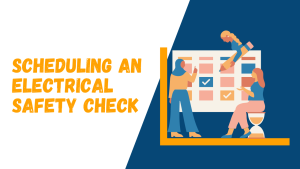
Scheduling an Electrical Safety Check is essential for ensuring the proper functionality and safety of any electrical system. It’s important to find professionals who are licensed and qualified to carry out these checks, as they can provide cost estimates before beginning the inspection process.
When searching for a professional electrician, make sure that they have experience with commercial or residential buildings similar in size and complexity to yours. Ask them about their qualifications, certifications, and past experiences when it comes to performing electrical inspections.
Additionally, inquire if they offer additional services such as upgrades or repairs during the check-up process.
It’s also critical that you discuss pricing prior to starting the inspection process; ask your chosen contractor what kind of fee structure they use and how much this particular job will cost. If possible, get a written quote from them so you know exactly what you’ll be charged for the work completed by the time the project is finished.
Doing this ensures transparency between both parties involved and eliminates surprises at checkout time. With careful research beforehand and clear communication during the consultation period, scheduling an Electrical Safety Check doesn’t have to be daunting – instead it should be seen as a necessary step towards protecting yourself and your property from potential hazards caused by faulty wiring!
Preparing Your Home Or Business
I’ll start by identifying any hazards, like frayed wires or exposed outlets.
Next, I’ll test the electrical systems to make sure everything is working properly.
Then I’ll check for any loose connections or damaged parts and make sure they’re fixed or replaced.
After that, I’ll inspect the wiring and circuit breakers to make sure they’re up to code.
I’ll also suggest any maintenance or upgrades that may be necessary.
Finally, I’ll provide a full report of my findings so you can have a better understanding of the safety of your home or business.
Identifying Hazards
Before I begin a electrical safety certificate check, one of the most important things I do is identify hazards.
This involves reviewing regulations and maintaining systems to ensure that all elements meet required standards for safety.
It’s especially important in homes or businesses where electricity is used on a daily basis, as it can be dangerous if not properly managed.
As part of my process, I inspect outlets, wiring, circuit breakers, appliances and other components for any signs of wear or damage.
I also assess how these items are installed and operated to make sure that they’re safe for use.
By regularly assessing and maintaining your home or business’s systems with an expert eye you can prevent potentially hazardous situations from occurring!
Testing Electrical Systems
Once I’ve identified the hazards, it’s time to move on to testing electrical systems. This means checking all components and making sure they’re up to safety standards.
To do this, I use different meters or testers that measure voltage, current, and other factors in order to detect any potential issues before they become a problem.
In addition, I also conduct visual inspections of each component looking for signs of wear or damage that could lead to an issue down the line.
By ensuring all electrical systems are functioning properly and safely you can rest easy knowing your home or business is safe from hazardous conditions!
Maintenance & Upgrades
Once I’m done testing the electrical systems, it’s time to move on to maintenance and upgrades.
It’s important to keep up with these tasks in order to ensure your home or business is running safely and efficiently.
Regular maintenance helps save energy and money by preventing potential issues from occurring down the line.
I typically inspect all components for signs of wear and tear as well as making sure everything is up to safety standards.
This includes checking outlets, wires, fuses, switches, circuit breakers, etc., looking for any problems that could cause a hazard if not addressed properly.
Additionally, I can also upgrade existing systems to make them more efficient while still meeting safety requirements.
By performing regular maintenance checks and updating electrical systems when necessary you can rest assured knowing your property meets all safety regulations while conserving energy!
Understanding The Inspection Process
Interesting fact: in the UK, an estimated 23% of residential fires are related to electrical malfunctions. This highlights the importance of ensuring all safety measures and regulations are met when it comes to electric installations.
When preparing for an electrical safety certificate check, there are a few steps that should be taken beforehand.
First, you should properly evaluate any risks associated with the installation by carrying out risk assessments. You can do this yourself or hire a specialist depending on what is needed.
Once the risks have been noted down, you’ll need to perform tests on the equipment and make sure that everything runs smoothly and safely before continuing with the inspection process itself.
It’s also important to make sure that all relevant documents such as warranty certificates, test results and product information sheets are ready for review prior to starting your inspection.
The last step would be making sure that any necessary repairs or maintenance has already been completed before beginning the inspection process. By doing so, it will help reduce potential hazards during testing while also providing proof of regular upkeep which is highly encouraged within most building regulations today.
Taking these steps when preparing for an electrical safety certificate check ensures that all aspects of safety are covered and up-to-date in accordance with industry standards.
Completing The Required Documentation
Now that we understand the inspection process, it’s time to complete the required documentation.
To ensure a successful electrical safety certificate check, you must review all applicable requirements and maintain relevant records. This should include any documents related to the installation of equipment since commissioning, as well as plans, drawings and calculations prior to certification.
It is also important to keep detailed records of maintenance activities going forward. This includes routine inspections, tests and repairs carried out on the system in accordance with approved procedures. It is essential that these documents are kept up-to-date so that they can be easily accessed during an electrical safety certificate check if needed.
Finally, having documented evidence of regular testing will help demonstrate compliance and provide peace of mind when it comes to passing an electrical safety certificate check. Therefore it is vital for your organization to have access to reliable sources of information about current regulations and standards regarding electrical safety measures.
Taking this pro-active approach will make sure that you are always prepared for any eventuality when completing an electrical safety certificate check.
Ensuring Compliance With Regulations
In order to successfully prepare for an electrical safety certificate check, it is essential to ensure compliance with regulations. To do this effectively, organizations should follow a few best practices while also maintaining records and updating standards in accordance with the latest industry guidance.
One of the most important steps in ensuring compliance with regulations is having clear protocols regarding any changes or updates that need to be made to existing systems. This includes keeping up-to-date on industry trends and understanding the specifics of current regulations. It’s critical that organizations develop policies so they can take proactive measures if needed.
Furthermore, making sure these policies are well documented will help provide clarity when communicating them internally and externally.
Organizations must also maintain records about their procedures and processes relating to electrical safety certification checks as part of good practice management. They should keep copies of all certifications from external bodies and make sure they have been properly signed off on by authorized personnel before being filed away securely.
Additionally, staff members should receive regular training on how to inspect equipment correctly in order to avoid potential hazards. As such, it’s paramount that organizations stay abreast of changing guidelines and update their standards accordingly – not only does this protect workers but it ensures legislative requirements are met too.
By following these key guidelines, organizations can confidently move forward knowing that they are adhering to the necessary safety regulatory framework for electrical safety certificates checks.
Seeking Professional Advice And Assistance
Having a comprehensive understanding of the regulations pertaining to electrical safety certificate checks is essential if you want to be compliant. However, it can also be beneficial to seek professional advice and assistance when preparing for such an inspection.
By hiring experts in this field, you are ensuring that any concerns or questions about meeting compliance requirements will be addressed quickly and accurately. In addition, asking questions of these professionals prior to the check being conducted can help ensure there are no surprises on the day of the inspection.
An experienced expert should have knowledge on how best to prepare for electric safety inspections, as well as know what areas may require additional attention or focus. Taking advantage of their expertise in this area can provide peace-of-mind while allowing you time to attend to other matters before the scheduled inspection date arrives.
Preparing adequately for an electrical safety certificate check requires a combination of one’s own personal knowledge base combined with the insights provided by trained professionals in this field. It is important not only understand current regulations but also have access to authoritative sources who can answer pressing inquiries along the way.
With adequate preparation, your next electrical safety certification check should proceed smoothly and without incident.
Frequently Asked Questions
How Long Does An Electrical Safety Certificate Check Take?
Are you wondering how long an electrical safety certificate check takes?
As an expert in this field, let me assure you: it’ll feel like forever!
Homeowners have a lot of responsibilities when it comes to electrical safety, and that means making sure the inspection is done right within prescribed time frames.
It’s no small task either – there are countless steps involved, from checking wiring to testing circuit breakers – all needing to be completed with precision for your family’s continued safety.
So don’t wait another minute; begin preparing now for the upcoming electrical safety certificate check so you can get it done quickly and efficiently.
What Type Of Electrical Hazards Should I Be Aware Of?
When it comes to electrical maintenance and safety, there are a number of hazards that you should be aware of. These include the risk of electric shock, fire caused by faulty wiring or overloaded circuits, and even electrocution due to contact with high voltage equipment.
It is also important to ensure that all outlets have been properly grounded and that any exposed wires are insulated. Additionally, all devices must be tested regularly for proper operation in accordance with safety protocols.
By staying vigilant and following these guidelines, you can help reduce the risks associated with electrical hazards.
Are There Any Regulations I Should Be Aware Of?
When it comes to an electrical safety certificate check, there are a few regulations you should be aware of.
Firstly, make sure that the equipment and wiring is compliant with all applicable electrical codes.
Secondly, ensure that all personnel involved in any repair or maintenance activities have proper certification requirements and training.
Lastly, if any inspections occur as part of the check-up process, they should also meet relevant industry standards.
Following these guidelines will help guarantee your property’s compliance when preparing for an electrical safety certificate check.
What Is The Cost Of An Electrical Safety Certificate Check?
The cost of an electrical safety certificate check can vary depending on the complexity and size of the job, but typically ranges between $150 to $500.
Securing funding for this inspection is essential in order to ensure that all standards are met and that any necessary repairs or replacements are completed according to local electrical codes.
An experienced electrician should be able to provide you with a quote based on your specific requirements so don’t hesitate to reach out if you have any questions about securing funding for an electrical safety certificate check.
Are There Any Specific Safety Measures I Should Take During The Inspection?
Safety is paramount during an electrical safety certificate check, so it’s important to take the right precautions.
Preparing for a thorough inspection can be daunting, but don’t worry – there are measures you can take to ensure everything runs smoothly and safely.
First off, make sure your wiring complies with all local regulations and that any necessary testing has been completed prior to scheduling your electrician visit.
It’s also wise to have all relevant documents on hand such as electrical testing results or safety reports in order to avoid delays during the inspection process.
So by taking care of these steps beforehand, your electrical safety certificate check should go off without a hitch!
Conclusion
It’s important to be prepared for an electrical safety certificate check, as it can save you time and money in the long run.
By following these steps, you will ensure that your property is compliant with all regulations and up-to-date with its safety standards.
As they say, ‘prevention is better than cure’, so make sure to take the necessary precautions before any inspection takes place.
I’m confident that by taking these measures you’ll have a successful electrical safety certificate check experience.
Good luck!



